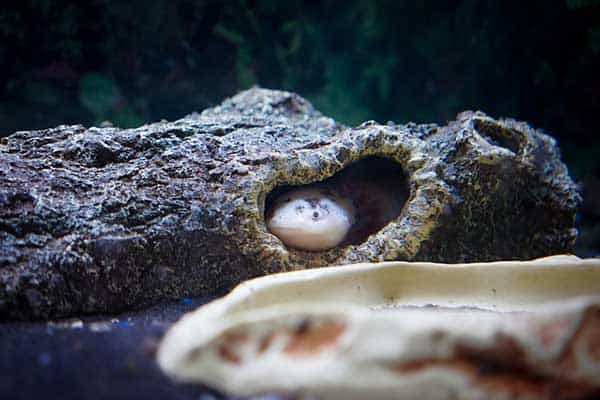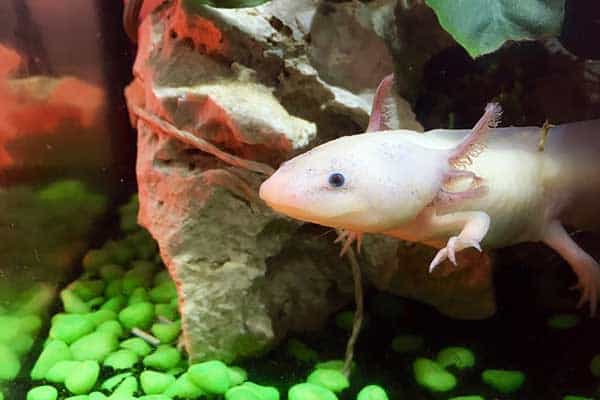The axolotl is a fully aquatic salamander native to Mexico. They have a primordial appearance that looks like something straight out of a paleontology textbook, and many people find them to be oddly cute.
Caring for them is quite different than caring for other amphibians, and in many ways it’s more like keeping a fish than a salamander. Here’s everything you need to know about keeping an axolotl.
Axolotl care sheet
Common name: axolotl
Scientific name: Ambystoma mexicanum
Range: A small region just outside of Mexico City
Lifespan: up to 15 years
Adult size: 6-18 inches long, but rarely longer than 12 inches
Temperament: Fairly placid, but young ones have a tendency to bite each other if kept together
1. Housing
Since axolotl are fully aquatic, you’ll need an aquarium, not a terrarium. The key difference being tha aquariums are fully waterproof, have a solid rather than a mesh top (to minimize evaporation) and are designed to accommodate the pumps and filters needed to keep the water clean.
One adult axolotl requires a 20 gallon aquarium. That’s really the minimum safe size- axolotls produce a lot of ammonia in their waste; in the wild, it’s immediately diluted by the water around them. In an aquarium, it could quickly build to dangerous levels. A large volume aquarium with very efficient pumps and filters is a necessity.

Recommendations
Aquarium Kit– The GloFish Aquarium kit is a great choice for axolotls, mainly because it’s the right size and it comes with the necessary filters and pumps included, which saves you a lot of money and hassle.
Hiding Spot– Axolotls do like having a dark place to hide. Hiding spots like this one can help them feel safe and secure in their aquarium.
Plants– Adding plants to the aquarium will help maintain the water quality while also providing a stimulating environment for your axolotl, and extra places for them to hide. This starter pack will supply you with plenty of live plants.
2. Temperature and lighting
The water should be kept between 57 and 68 degrees fahrenheit, and should not be allowed to exceed 75 degrees. That means that, while most reptiles and amphibians require a heat source in their tank, your axolotl may actually need an aquarium chiller to keep the water from warming up too much.
Axolotls don’t require any special lighting, and in fact will need a couple of dark places to hide. The only lighting you’ll need is for your viewing pleasure, and perhaps for any plants you add to the aquarium.
Recommendations
Chiller– You may need an aquarium chiller, especially if you live in a warm climate. This one is a great choice, as it’s definitely powerful enough to chill a 20 gallon aquarium and will work with a larger tank if you ever decide to upgrade.
3. Diet and feeding
Axolotls are easy to feed. You can feed them nothing but nightcrawlers and they’ll thrive. You can also give them frozen bloodworm cubes, and even frozen shrimp from the supermarket (thawed and cooked). Brine shrimp and frozen fish food are also good choices. In the wild they’ll eat a variety of snails, worms and small fish.
Don’t give them live feeder fish, as these can often carry parasites. It’s also not a good idea to give them pinkie mice, as these aren’t healthy food for axolotls. You also don’t need to provide any mineral supplements for them.
Recommendations
Worms– nightcrawlers like these are a perfect food for your axolotl. They’ll supply all their nutritional needs, and it’s affordable.
4. Substrate
Even though they’re fully aquatic, axolotl do require substrate. They spend much of their time on the bottom of the tank, unlike fish who tend to swim and hover in the water column. Gravel is a dangerous choice, because axolotl have a tendency to swallow it.
Aquarium sand is the best substrate for these salamanders. It provides a comfortable bottom surface for them to rest on without posing any health risk.
Recommendations
Sand– You’ll need high quality aquarium sand for substrate. This is a popular brand that’s safe for use in axolotl tanks.
5. Maintenance
Maintaining an axolotl aquarium isn’t too different from maintaining a fish aquarium. You’ll need to change the water once a week or so, using a siphon to clean the sand on the bottom. Check the filter to make sure it doesn’t need to be changed as well.
Recommendations
Siphon- a good siphon makes it easy to change the water in your aquarium, and to clean the sand on the bottom. This one is great because it’s suitable for cleaning sand or gravel, so if you have multiple aquariums with different species you only need the one siphon.
6. Handling
Axolotls don’t respond to handling well. For one thing, they’re fully aquatic and can’t breathe air, so you can’t pick them up and take them out of the water. Plus, like all amphibians, their delicate, porous skin makes them extremely sensitive to toxins. Anything on your hands will be absorbed directly into their bloodstream.
They’re also soft-bodied, delicate creatures that can be easily injured. You will need a net to remove them from the aquarium when you clean it, but you must be careful to use a net with fine enough mesh that their fingers and toes can’t get caught in it.
product recommendations area
Net– This net has a fine enough mesh that you won’t risk injuring your axolotl, and it’s big enough that it can catch and hold a fully grown specimen.
7. Other things to know
Axolotls are endangered in the wild, and so they’re illegal to own as pets in many states. In other states it’s illegal to import an axolotl across state lines, so you’ll have to find a breeder in your state. Be sure to check your state laws before you buy an axolotl.

Axolotls as pets
Axolotls make fascinating, unique pets. They’re fun to watch and they make a great conversation starter, since many people will never have seen one before. As long as you provide the right size habitat and keep the water clean, they aren’t particularly difficult to care for.
Still, these aren’t necessarily the best pets for beginners. They’re very sensitive to waste levels in their environment, and the water needs to be kept very clean. If you’ve never kept an aquarium before, you probably shouldn’t start with an axolotl, even if you’ve kept other amphibians in terrariums.



